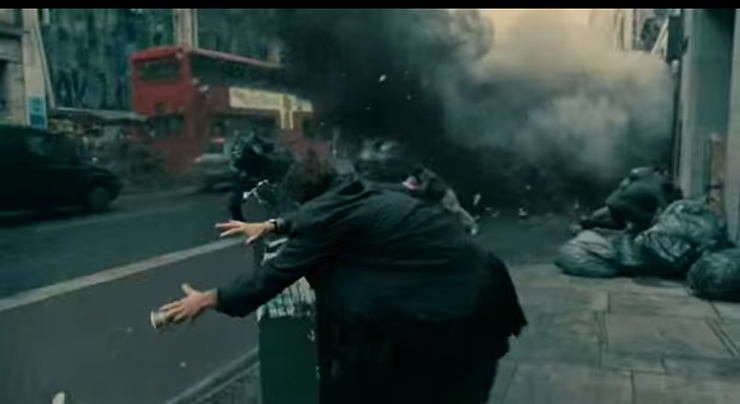T.G321

Children of Men (2006, Alfonso Cuarón, USA)
The first two minutes of Children of Men contains many elements that are reminiscent of past media studies productions: the majority of the editing seems easily achievable for someone with relatively little experience, and the verisimilitudic location combined with the surreal plot is something that many students strive to utilise. The diegetic sound of a news reporter's voice over a black screen, the synchronous non-diegetic orchestral music, and the simple white title over a black background that pops up at the end of the sequence, are all elements that are seemingly overused in students' productions, which suggests that Children of Men has had an influence on many Media Studies projects. This implies that the film has a significant appeal to young producers; I will analyse this appeal on this page.
On the other hand, there are some features which are likely to be intractable for us to reproduce, such as having so many people seemingly oblivious to the camera's presence, and the large explosion.
The most striking aspect of the sequence is the ambiguity; the audience is clueless as to why the "youngest person on Earth" was 18 years old, or why so many people are affected by the news of his death.
The film's incontrovertible allure is created by an assortment of qualities, which is likely to have started with audience research; something that we will need to conduct, prior to producing our sequence. The film had a reasonable budget of approximately £49 million, which arguably increased its capability of permeating all four major demographic quadrants of the moviegoing audience, although a study for the Journal of Media Psychology showed that males and females enjoy the thriller genre almost equally, suggesting that there are few devices available to use to attract a specific gender to a thriller film. Click on the image to go to the full study.
The first shot shows Theo Faron making his way through a crowd in a cafe. This immediately defines him as distinct from the crowd, symbolising his ability to surpass the rest of the human population to take action and be the protagonist. This shot also increases the ambiguity of the situation, by depicting the scale of importance that the news has.

A tracking shot shows Theo walking out of the cafe. By using a prolonged shot with some swaying, almost as if the camera is walking like a human, the audience is forced to feel as if they are in the film's universe; the camera moves with a personified quality, and when we reach the chaos of the busy street, the camera tilts up towards the sky, almost in awe. The camera represents the audience's perspective of the film's universe, and the tilt suggests that the camera is, like the audience, new to the universe, which gives the audience a feeling of being led, at the same time as alienated. This also attempts to add verisimilitude to a surreal situation, by embedding, and therefore captivating the audience.

The tracking shot continues to follow Theo along the street, which ... In fact, the film received widespread acclaim for its single-shot action sequences.
This shot also introduces a possible juxtaposition of class, as there are tut-tut style vehicles alongside more sophisticated cars. Other details of the mise-en-scène inflate the ambiguity, presence, and spectacle

The tracking shot continues to follow Theo as he walks down the street. From this point there are subtle hints of impending danger, such as the man who nearly walks into Theo, which foreshadows his close proximity to the explosion.

A slightly more explicit foreshadowment is an unclear subject on a screen in the background, which iterates the motion of an explosion, milliseconds before the cafe explodes.

The tracking shot carries on to show the explosion, insinuating that this kind of violence is normal in the film's world.

After the editing pace climaxes, the title of the film is shown. The font is simplistic and bold, with a solid black background to make the text more pronounced. The letters are all capitalised, presumably to represent the film as serious, with an immediate impact, and lots of thrills, due to the connotation of shouting.

